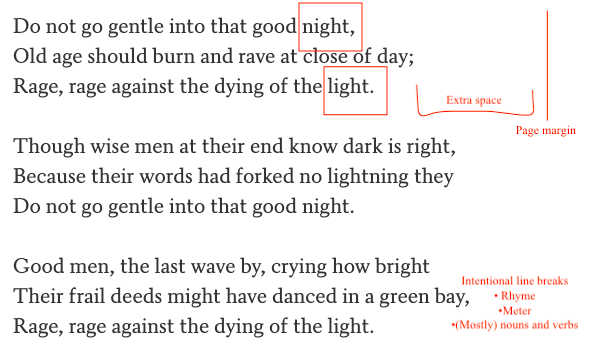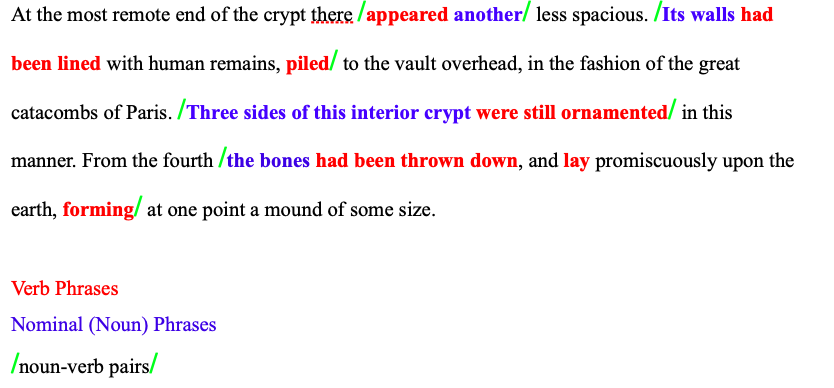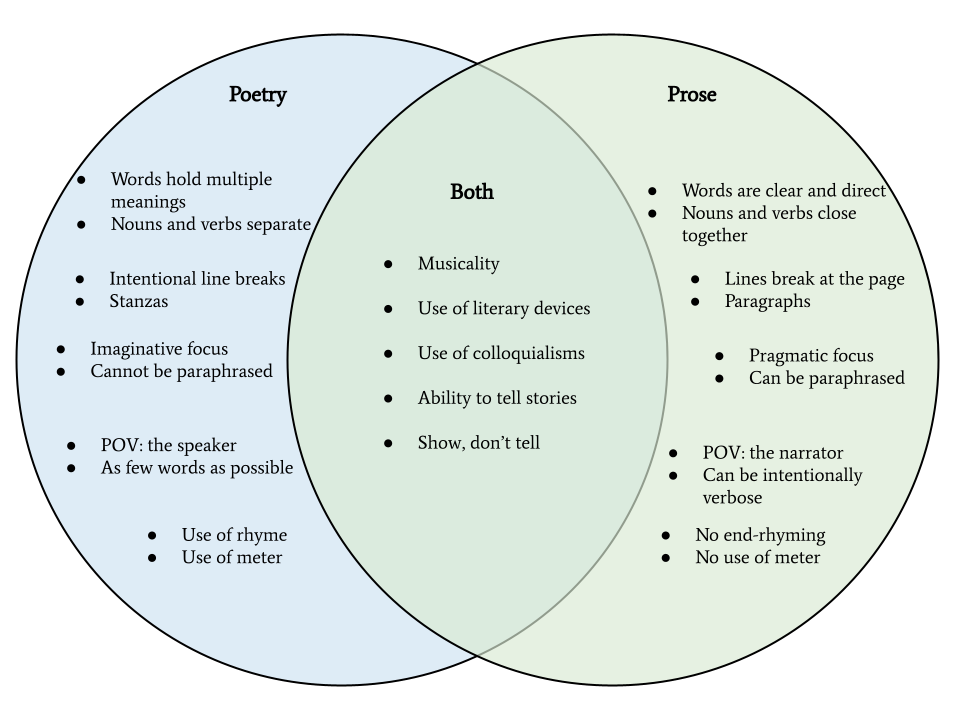Good Poetry Vs Bad Poetry
The difference between prose and poetry seems easy to explain: one has blocks of text and fully-fleshed characters, the other has line breaks and pretty words. That's it, right?
Despite their visual quirks, prose and poetry share many similarities: prose can be musical, poetry can have plots and characters, and both are millennia-old traditions. As such, it would be wrong to prescribe a rigid decision tree for writing prose vs. poetry—many writers have both in their toolkits, relying on each form to communicate different truths.
"Poetry creates the myth, the prose writer draws its portrait."
—Jean-Paul Sartre
So what is the difference between poetry and prose? And which should you write for which occasions? Again, we won't give hard-and-fast rules, but we can explore their differences in depth and discuss their possibilities.
First, we'll discuss the features of prose and poetry independently, then we'll loop back to examine both their differences and their areas of overlap.
Prose vs. Poetry: Defining Prose
Prose is the more common writing form that everyone is comfortable reading and writing. This article relies on prose—as do most (but not all!) novels, and just about all news stories, instruction manuals, scientific papers, and so on.
Prose Versus Verse: Line Breaks
The most straightforward rule of thumb for knowing that you're reading prose (as opposed to its counterpart, verse) is that there are no defined line breaks: words go all the way to the edge of the page without "turning back" early.
A rule of thumb for prose (as opposed to its counterpart, verse) is that there are no defined line breaks.
Again, that's how this blog article works, along with most other writing, from tweets to short stories to scientific papers.
So why would you stop writing prose, and move over to the with-line-breaks type of writing known as verse? The line breaks aren't arbitrary, but reflect an underlying difference in how prose and verse tend to be structured. To quote the always-helpful Wikipedia:
"Where the common unit of verse is based on meter or rhyme, the common unit of prose is purely grammatical, such as a sentence or paragraph."
So is verse (writing with line breaks) always poetry? While two are often used synonymously, defining poetry requires more than just scanning for line breaks: as we'll discuss below, poetry is also about the rich and musical use of language.
Prose is not the counterpart of poetry, but the counterpart of verse.
So prose is not the counterpart of poetry, but rather the counterpart of verse. So verse is not what strictly defines poetry. In fact, not all poetry is in verse—specifically, prose poetry isn't. In other words, prose and poetry do overlap, whereas prose and verse don't.
Most poetry is in verse, but some poetry is in prose.
We go into more detail on line breaks, stanzas, and the use of page space in the sections below.
Check Out Our Poetry Writing Courses!

From Writing Circles to Poems of Gratitude and Hope
with Susan Vespoli
November 17th, 2021
Poetry is a powerful method for healing and happiness. Write poems about gratitude and hope in our intimate, live-video writing circles, with instructor Susan Vespoli.



Crafting the Poetry Novel for Young Adults
with Kelly Bingham
January 12th, 2022
Even if you've never written poetry before, you can begin the rewarding process of crafting a poetry novel for Young Adults. Is there a market for novels written in verse? Are they well received? Yes, there is, and yes, they are!

Poetry Workshop: Bring Your Poems to Life
with Rosemary Tantra Bensko
January 19th, 2022
Join us for this workshop on creating powerful poems—poems that are clear and organized, fresh and moving, full of life.
Prose is More Functional than Poetry
A helpful pattern in understanding prose vs. poetry is as follows: prose tends to work in clearer meanings, and to be less musical (that is, working with the inherent rhythms and sonic properties of language) and less densely packed with meanings, literary devices, and associations, than poetry.
As such, prose writing tends to be linear: while a prosaic sentence can twist and turn, it tends to share clear information, generally in a logical order.
Prose tends to work in clearer meanings, and to be less musical and dense, than poetry.
Again, exceptions exist, notably prose poetry: prose writing—writing with no line endings or defined rhythmic meter—that is highly musical and dense, and that is generally more impressionistic and multifaceted than most prose in the meanings it conveys.
And then there's prose writing that is enigmatic and dreamlike rather than clear and orderly, such as the stream-of-consciousness prose writing in James Joyce's Ulysses.
These exceptions prove the rule, though: most other prose, from this blog article your friend's next Facebook post to Mary Shelley's Frankenstein, tends to follow the delineation described here.
We'll allow Hemingway a last word with a slightly macho, not-applicable-to-every-prose-work, but still helpful description of prose: "Prose is architecture, not interior decoration."
Sound good? To get a stronger feel for prose and further acquaint yourself with prose writing, take a look at the readings below.
How to Read Prose
This article gives close reading strategies for prose writing.
How to Read Prose: Close Reading Strategies for Prose Writers
Further Readings in Fiction and Nonfiction
The articles below outline helpful practices for numerous kinds of prose writing, from flash fiction to the novel, focusing especially on the common ingredients of storytelling.
- Crafting a Story Outline
- Freytag's Pyramid
- Literary Devices in Prose
- Writing Flash Fiction
- Writing the Short Story
- Writing the Novella
- Writing the Novel
Prose vs. Poetry: Defining Poetry
Poetry is the oldest literary form, predating the written word (and therefore, prose) by several millennia. Up until the printing press revolutionized the distribution of literature, poetry was the main form for storytellers, who used meter and rhythm to perform oral retellings of their work.
So, what is poetry? As we've seen in our introduction to prose above, most—but not all—poetry is written in verse: writing with line breaks, organized around rhythm or meter rather than grammar. Still, we've also seen that verse is not what defines poetry, nor is all poetry based in verse.
So it's not simply another word for verse. Is there an agreed-upon artistic definition of poetry as a literary form? (Spoiler: No.)
Artistic Definitions of Poetry Vary
Artistic definitions of poetry change from poetic movement to poetic movement—and from poet to poet.
For example, William Wordsworth said that poetry is "the spontaneous overflow of powerful feelings… recollected in tranquility." This sentiment—largely reflective of the Romantic era—certainly rings true for some poetry. However, New Formalist poets work with poetry to distill and reflect emotion through form and meter: in other words, structure over emotion.
The point is, there's no singular way to define or understand the artistic aims of poetry. Rather, all poets must define these aims for themselves and write accordingly.
Poets must define the artistic aims of poetry for themselves and write accordingly.
Learning about poetry requires familiarizing yourself with what other poets have already done. This list of poetry movements can jumpstart your understanding of poetry's complex and various histories.
Poetry Uses Language Richly
Good poetry, from any tradition, sings and resonates beyond the merely "prosaic."
Whatever literary tradition you ascribe to, poetry has a clear job to be rich, musical, evocative. Good poetry, from any tradition, sings and resonates in a way that goes beyond the merely "prosaic," as in the following poem excerpt by Derek Walcott:
You will love again the stranger who was your self.
Give wine. Give bread. Give back your heart
to itself, to the stranger who has loved you
all your life, whom you ignored
for another, who knows you by heart.
So poetry, in any tradition, is the "cheesecake of language": packed to the brim with sonic and expressive power. In poetry, it's not enough to make a rational point straightforwardly, like the prosaic sentence you're reading is doing.
Samuel Taylor Coleridge said this beautifully, and we can give him the last word in defining poetry.
"Poetry: the best words in the best order."
—Samuel Taylor Coleridge
Cool, right? If you'd like to learn more, check out our guides for reading and understanding poetry.
How to Read Poetry
This article gives close reading strategies for poetry writing.
How to Read Poetry Like a Poet
Further Readings in Poetry
The articles below outline helpful practices poetry writing, including deep dives on common literary devices in poetry and established poetry forms.
- Literary Devices in Prose
- Poetry Forms
- Writing and Publishing a Poetry Book
Poetry vs. Prose: A Clear Example of Each
Let's cap the definitions of poetry and prose above by simply giving a clear example of each.
Here is some beautiful fiction writing that is definitely prose:
They were nearly born on a bus, Estha and Rahel. The car in which Baba, their father, was taking Ammu, their mother, to hospital in Shillong to have them, broke down on the winding tea-estate road in Assam. They abandoned the car and flagged down a crowded State Transport bus. With the queer compassion of the very poor for the comparatively well off, or perhaps only because they saw how hugely pregnant Ammu was, seated passengers made room for the couple, and for the rest of the journey Estha and Rahel's father had to hold their mother's stomach (with them in it) to prevent it from wobbling. That was before they were divorced and Ammu came back to live in Kerala.
—Arundhati Roy, The God of Small Things
And here is some writing that is definitely poetry:
We are such stuff
As dreams are made on; and our little life
Is rounded with a sleep.
—Shakespeare, The Tempest
5 Similar Features of Prose and Poetry
Having defined prose and poetry above, the reality is that they can be more similar than you might imagine. We'll discuss their differences in a moment, but first, it's important to understand the shared potential that each form holds:
- Musicality and rhythm
- Use of colloquial speech
- Use of literary devices
- Ability to tell stories
- Show, don't tell
1. Musicality and Rhythm
It's a common misconception that only poetry can be musical. While rhythm and meter are important aspects of a poem's construction, musicality begins with language, not with structure.
An immediate example of "musical prose" is The Great Gatsby by F. Scott Fitzgerald. Susan Bell, writer of The Artful Edit, argues that Gatsby finds its success precisely because of the story's musical, elegant storytelling—certainly, the book has a charged poeticism that feels just as decadent and tasteful as the high society of the Roaring Twenties. Below is some undeniably musical prose:
No — Gatsby turned out all right at the end; it is what preyed on Gatsby, what foul dust floated in the wake of his dreams that temporarily closed out my interest in the abortive sorrows and shortwinded elations of men.
2. Use of Literary Devices
Things are like other things, which is the essence of literary devices. While some devices are unique to each form—poems have enjambment, prose can begin in media res—a successful piece of writing requires literary devices.
3. Use of Colloquial Speech
Yes, some writing uses lofty and erudite language. However, contemporary prose and poetry writers, from all eras, recognize the importance of speaking to their audience.
Colloquial speech is one way of speaking to your audience. A colloquialism is a turn of phrase with a specific social and temporal context. For example, "groovy" belongs to the American 1970s, Victorian Brits called a brave person "bricky," and Gen Z'ers "stan" on Twitter.
In literature, Jay Gatsby's "old sport" is just as colloquial as the poem "A Study of Reading Habits," which uses phrases like "right hook" and "load of crap."
4. Storytelling
Another common misconception is that poetry doesn't tell stories. While fiction and nonfiction are the genres of prose, poetry also possesses a powerful narrative voice.
Singular poems can tell grand stories, especially poetry in antiquity. The Epic of Gilgamesh, The Odyssey, and Beowulf are all stories in verse, as are novel-poems like Autobiography of Red.
Additionally, contemporary poetry collections often tell stories, just with less linearity. Louise Gluck's collection Wild Iris is told from the perspective of a flower, and as the seasons change, the flower observes the infinite singularity of mankind, God, and the Universe.
5. Show, Don't Tell Writing
It's important for storytellers to demonstrate their ideas without spoon feeding the reader. In other words, writers should Show instead of Tell.
Don't tell me the moon is shining; show me the glint of light on broken glass.
—Anton Chekhov
We consider "Show, Don't Tell" a golden rule of writing. Brush up on it here!
10 Differences Between Prose and Poetry
We've discussed their similarities, but the difference between poetry and prose is usually fairly clear in practice. The following ten items distinguish the two. To help demonstrate our point, we represent each form with a well known piece of literature. Poetry examples were pulled from Dylan Thomas' "Do Not Go Gentle Into That Good Night," and prose examples come from "The Cask of Amontillado" by Edgar Allan Poe.
1. Prose vs. Poetry: Use of Page Space
In prose, a line of text begins and ends at the margins of the page. In poetry, the author uses shorter lines, broken before the page margins to introduce multiple meanings. Line breaks are an enduring feature of what differentiates prose and poetry, adding extra emphasis to certain words and sounds.
You'll notice in prose that a partial line occurs only before a new paragraph.

In poetry, the line breaks mean something more intentional. The ending words can help uphold meter and rhyme schemes, and it also emphasizes important words: "night" and "light" are repeatedly pit against each other in Thomas' villanelle.

2. Prose vs. Poetry: Paragraphs vs. Stanzas
Prose passages divide single ideas into sentences, and those sentences go on to form paragraphs. A new paragraph signifies the introduction of new ideas or the continuation of relevant information.

The equivalent of a paragraph in poetry is the stanza. Stanzas are groupings of lines which act as units of meaning, with different stanzas containing different ideas and images.

3. Prose vs. Poetry: Single vs. Multiple Meanings
In prose, the meaning of each word is usually straightforward, with double meanings (like puns and irony) clearly expressed. Most prose relies on clear meanings to deliver clear, linear messages.
By contrast, the language of poetry contains multitudes. One word can hold many different meanings, and ideas can be broken into both sentences and lines.
Take the line "old age should burn and rave at close of day." The word rave can mean multiple things: it can mean to rant and rave as old people (stereotypically) do, or it can mean to rage and fight against. The pun here is intended to energize the reader,
4. Prose vs. Poetry: Noun-Verb Placements
In Standard English, which is the common (but not default) language of prose, nouns and verbs are found close to each other. This is a facet of "clear communication"—it's important to know who is doing what as efficiently as possible.
We have bolded the noun-verb pairs in an excerpt from both the poem and prose piece.
Poetry

Notice how the noun-verb pairs can stray from each other much more easily in poetry. Dylan Thomas inserts a noun-verb pair between a noun-verb pair in each stanza—which is much harder to use effectively in prose.
Prose

Notice that, in prose, a noun can have multiple verbs attached to it, but the first verb is almost always next to the noun.
5. Prose vs. Poetry: Rhyme (Sometimes)
There are two types of rhyme: internal and external rhyme. External rhyme occurs at the ends of lines, such as the many "-ight" words in Thomas' poem.
Internal rhyme refers to words that rhyme with each other inside the same beat. These rhymes are not always intentional or charged with meaning, but they occur, such as in this sentence from Poe's story:
"We had passed through walls of piled bones, with casks and puncheons intermingling, into the inmost recesses of the catacombs."
Bones and catacombs aptly rhyme with each other. Note, rhyme is not a necessary feature of any prose and many poems. Though some poetry forms do require rhyme schemes, contemporary poets tend to eschew rhyming.
6. Prose vs. Poetry: Meter (Sometimes)
Like rhyme, meter is an (often) optional component of poetry writing. Meter refers to the stress patterns of syllables and the number of syllables per line. Well-executed meter can give poetry a certain musical quality.
Thomas' poem is written in iambic pentameter, a requirement of the traditional villanelle form. This means there are 10 syllables in each line, following an unstressed-stressed pattern. To understand syllable stress, read Thomas' poem out loud, and note how every second syllable is emphasized harder than the first.
Prose does not rely on meter to tell a story.
Prose does not have any metrical requirements, and thank goodness for that. Meter can be extraordinarily tough to impose on a poem, but it also affects how the reader interprets the piece. However, prose does not rely on meter to tell a story, as these poetry devices often instill multiple meanings in a piece.
7. Prose vs. Poetry: Pragmatic vs. Imaginative Focus
On a macro-level, the vision of poets and prose writers tends to differ. Prose has a pragmatic focus, meaning that each word should clearly advance a specific idea or narrative. The focus of prose is storytelling, so the author has a duty to use words diligently.
While poetry can tell stories, a poem rarely focuses on plot points, settings, and characters.
While poetry can tell stories, a poem rarely focuses on plot points, settings, and characters. Rather, poetry has an imaginative focus. Words are allowed to break their conventional bounds in the goal of expressing emotions, and ideas can stack upon each other like grains of sand in a sand castle.
So, what's pragmatic about Poe, and what's imaginative about Thomas? Every word in Poe's piece describes details and events that push the reader towards the climax. At no point does the reader jump out of the narrative to speculate or stargaze.
In Thomas' poem, the words don't point the reader towards a specific event, but they do encourage the reader to think deeply about abstract ideas. Old or young, the reader will contend with ideas of life, death, justice, goodness, and the judgment against our souls. In 19 lines of mostly concrete images, the poet asks us to read imaginatively—and in the process, to learn what we believe.
8. Prose vs. Poetry: Paraphrasability
A piece of prose can be summarized. If you ask "what is 'The Cask of Amontillado' about?", it is possible to paraphrase the story and get the gist of its deeper meaning. In short, Poe's story observes a man desperate for revenge, only to find that revenge often hurts both the punisher and the punished.
Poetry is generally harder to summarize than prose, because it tends to include greater multiplicities of meaning.
Poetry is generally harder to summarize than prose, because it tends to include greater multiplicities of meaning. No one can tell you what a certain poem means. They can tell you what it isn't—for example, "Do Not Go Gentle" is not about heartbreak, war, or the summertime—but deciding what a poem means requires a reader's own attention.
For example, one could summarize Thomas' poem as "an ode to Thomas' dying father, with a vengeful bent against mankind's eventual death." But, does saying that invoke Thomas' juxtaposition of light and dark? His use of rhyme to draw a conceit? His need to believe in the transience of the soul? By the time you've summarized the poem, you've written something as long as the poem itself. Poetry cannot be paraphrased.
9. Prose vs. Poetry: Point of View
Prose and poetry treat "point of view" in very different ways. A point of view (POV) refers to who is telling the story. The storyteller doesn't always have a name or a face, but they do inevitably change how a story is read.
In prose, there are 4 main POVs:
- First Person (I): The story is told in the first person, from a character who is either the protagonist or adjacent to the protagonist. The Cask of Amontillado uses the first person POV.
- Second Person (You): The story is told in the second person. Often, the writer will substitute "the protagonist" for "you," making the story's actions feel more intimate and personal. Second Person storytelling is rare, but not unheard of.
- Third Person Limited (He/She/They): The story is told in the third person, and it focuses on the perspective of the protagonist. We have access to most of their thoughts and feelings, but our access to other people is limited by the protagonist's perspective.
- Third Person Omniscient (He/She/They): The story is told in the third person, and the narrator has access to everyone's thoughts, feelings, and actions. We can jump from person to person with ease, interweaving webs of complex narratives together.
Some stories will also take a Third Person Mixed approach, meaning the meat of the story is told from the protagonist's perspective, but the reader occasionally jumps to someone else's POV or to a historical time period.
While poetry can use the same pronouns (I/You/He/She/They), it uses POV differently. A poem is always told from the perspective of "the speaker." The speaker can be the poet themselves—Dylan Thomas is certainly the voice behind his poem, and he is certainly talking to his father. However, the correct approach is to always call the poem's POV "the speaker," as a poem can inhibit many different voices at once. Finally, poetry is much easier to apply to yourself when the speaker isn't anyone in particular.
10. Prose vs. Poetry: Concision
Prose and poetry writers should both write concisely. Concise writing eschews redundancies and makes every word count. However, concision means something different for the two forms.
In prose, concision generally means that not a word is wasted in conveying information. Concise prose expresses its meaning clearly.
Concise prose expresses its meaning clearly.
Of course, good prose can still be long-winded, as long as this heightens the effect of the work. Take this sentence from Poe's story:
"It must be understood that neither by word nor deed had I given Fortunato cause to doubt my good-will. I continued, as was my wont, to smile in his face, and he did not perceive that my smile now was at the thought of his immolation."
These sentences are 19 and 27 words long, respectively. They can also be summarized as follows: "Fortunato thought my smile bore good-will, not the desire to immolate him."
What does Poe's long-windedness afford him? Despite being easily paraphrased, every word does count in these two sentences, because they are a part of the narrator's characterization. He is a long-winded schemer, and that affects how the story must be told, since Poe has chosen the first person to make us intimate with the narrator's internal conflict.
Poetry is a different situation. Because poetry has line breaks, stanzas, and (sometimes) rhyme and meter, its concision takes a different form. In a poem, it's great if every word contains heavy meaning; it's even greater when words contain multiplicities and challenge the reader's ideas. Economy in poetry is maximizing its impact, musicality, and richness—not necessarily its clear, single meaning.
Economy in poetry is maximizing its impact, musicality, and richness—not necessarily its clear, single meaning.
If you stretched a poem into prose, it would read like a terrible short story, because the concision afforded to poetry is different than that of prose. Concise prose focuses more on clarity of meaning, and poetry more on maximizing the richness and impact of every syllable.
Poetry vs. Prose Venn Diagram

Prose vs. Poetry: A Final Note On Literary Binaries
Any article like this risks making literature seem binary, as though prose and poetry were totally discrete entities; so in closing, it's good to note again that writers, especially contemporary writers, often work at the intersection of prose and poetry, resulting in genres like the prose poem, the lyrical essay or the poetry novel. (And we haven't even touched on scriptwriting, which is a different form of communication altogether.)
There is much to explore outside of poetry and prose; this article simply covers the basics. As you advance on your writing journey, don't be afraid to experiment with words outside of the traditional "prose vs. poetry" binary. You might be shocked by what you can accomplish!
Explore both Prose and Poetry at Writers.com
Whether you're experimenting with poetry, fiction, or creative nonfiction, Writers.com has the classes to help you succeed. Take a look at our upcoming courses—and gain valuable insights from our instructors and writing community.
Take your next online writing course with our award-winning instructors!
Browse our upcoming courses by category:
- Online Fiction Writing Courses
- Online Novel Writing Courses
- Online Short Story Writing Courses
- Online Stage and Broadcast Writing Courses
- Online Creative Nonfiction Writing Courses
- Online Personal Essay Writing Courses
- Online Memoir Writing Courses
- Online Poetry Writing Courses
- Online Lifestyle and Wellness Writing Courses
Source: https://writers.com/prose-vs-poetry